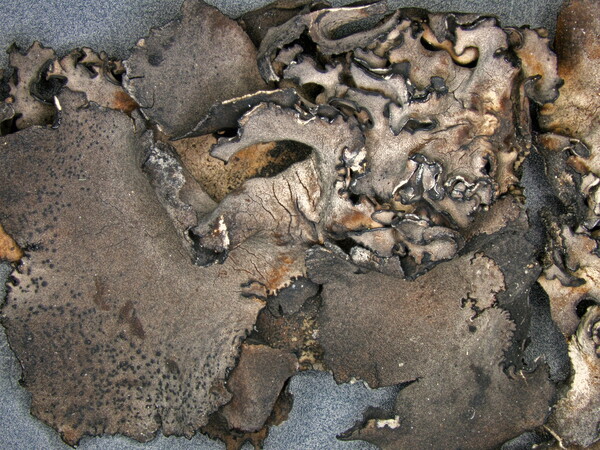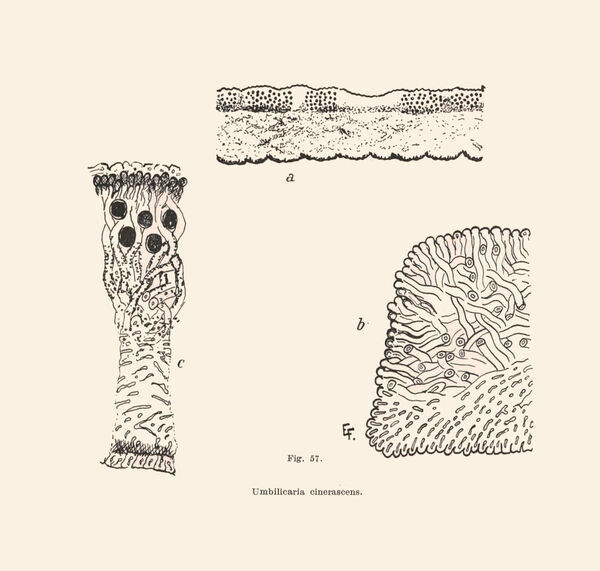Umbilicaria cinerascens (Arnold) Frey
Hedwigia, 71: 115, 1931. Basionym: Gyrophora cinerascens Arnold - Verh. zool.-bot. Ges. Wien, 25: 438, 1875.
Synonyms:
Description: Thallus foliose-umbilicate, heteromerous, dorsiventral, usually polyphyllous, 3-4 cm wide, 0.1-0.3 mm thick, rigid, attached by a central holdfast. Lobes ascending in the center, more or less adpressed towards margins, moderately incised, with undulate and perforated margins which sometimes have an eroded cortex. Upper surface mouse-grey, sometimes with cinnamon brown patches, dull, smooth to slightly rimose; lower surface black, sometimes dark grey along the margins, erhizinate, distinctly areolate only around the umbilicus, almost completely (except around the umbilicus) covered in simple to rarely 1-3-septate, dark brown, spherical to rarely ovoid thalloconidia measuring c. 8 x 7 µm. Upper cortex palisade-plectenchymatous, 10-15 μm thick, with a discontinuous necrotic layer; medulla white; lower cortex scleroplectenchymatous, 15–35 µm thick, dark brown. Apothecia very rare (not observed in Italian material), black, leiodisc. Epithecium brown; hymenium colourless; paraphyses simple or sparingly branched, septate, the apical cells more or less swollen; hypothecium thick, dark. Asci 8-spored, elongate-clavate, thick-walled, with an amyloid apical dome, Umbilicaria-type. Ascospores simple, hyaline, ellipsoid, 7-12 x 5.5.-8.5 μm. Photobiont chlorococcoid. Spot tests: cortex K-, C-, KC-, P-; medulla K-, C+ red, KC+ red, P-. Chemistry: medulla with gyrophoric acid.
Growth form: Foliose, umbilicate
Substrata: rocks
Photobiont: green algae other than Trentepohlia
Commonnes-rarity: (info)
Alpine belt: very rare
Subalpine belt: extremely rare
Montane belt: absent
Dry submediterranean belt: absent
Humid submediterranean belt: absent
Padanian area: absent
pH of the substrata:
1 2 3 4 5
Solar irradiation:
1 2 3 4 5
Aridity:
1 2 3 4 5
Eutrophication:
1 2 3 4 5
Poleotolerance:
0 1 2 3
Altitudinal distribution:
1 2 3 4 5 6
Rarity
absent
extremely rare
very rare
rare
rather rare
rather common
common
very common
extremely common
Loading data...
Occurrence data
Predictive map
Growth form: Foliose, umbilicate
Substrata: rocks
Photobiont: green algae other than Trentepohlia
Commonnes-rarity: (info)
Alpine belt: very rare
Subalpine belt: extremely rare
Montane belt: absent
Dry submediterranean belt: absent
Humid submediterranean belt: absent
Padanian area: absent
pH of the substrata:
| 1 | 2 | 3 | 4 | 5 |
Solar irradiation:
| 1 | 2 | 3 | 4 | 5 |
Aridity:
| 1 | 2 | 3 | 4 | 5 |
Eutrophication:
| 1 | 2 | 3 | 4 | 5 |
Poleotolerance:
| 0 | 1 | 2 | 3 |
Altitudinal distribution:
| 1 | 2 | 3 | 4 | 5 | 6 |
Rarity
absent
extremely rare
very rare
rare
rather rare
rather common
common
very common
extremely common
Loading data...
Occurrence data
Predictive map








